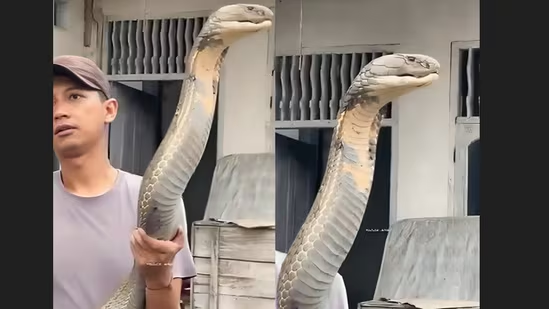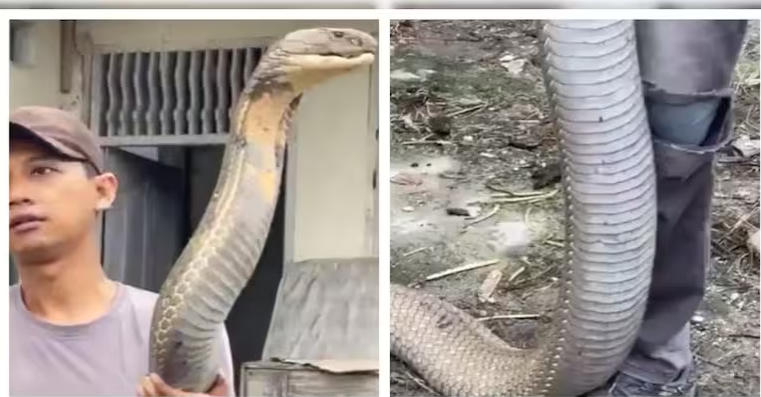12-Foot King Cobra Handled Bare-Handed by Man in Mesmerizing Forest Officer Video
12-foot King Cobra handled bare-handed by man in mesmerizing forest officer video, showcasing the snake’s true scale and sparking massive online reaction.
The Viral Encounter with the King Cobra
In the ever-evolving digital landscape where content travels across platforms in a matter of seconds, a recent 11-second video has emerged as a viral sensation, drawing the attention of wildlife enthusiasts, conservationists, and general audiences alike. The footage, shared by Indian Forest Service (IFS) officer Parveen Kaswan, captures a moment that is as breathtaking as it is instructive: a man fearlessly holding an enormous King Cobra with his bare hands.
The video opens with a striking visual—a calm individual gripping the thick, scaled body of a King Cobra. The snake, known for its massive size and potent venom, appears alert but unagitated, and the man’s composure suggests either a high level of expertise or a rare moment of mutual non-aggression. What has made this clip viral is not merely the shock factor but the sheer awe it inspires. In just 11 seconds, the footage encapsulates the magnificent scale of one of nature’s most feared yet revered reptiles.
Kaswan, a respected voice in the Indian forestry and conservation sector, accompanied the video with a caption that invites reflection and learning: “If you ever wondered about the real size of King cobra. Do you know where it is found in India? And what to do when you see one?” His questions serve as a reminder that such content is not only for entertainment but also an opportunity to educate the public on biodiversity and safe wildlife interactions.
Online Reactions and Public Fascination
Since its release, the video has elicited a torrent of responses across social media platforms. The range of reactions varies from astonishment at the King Cobra’s size to genuine fear and concern for the man’s safety. One user recounted a personal encounter: “Seen once. Was with a snake charmer. It was about 17 feet. And I wish I had never seen one again in the wild. Just the size of them is enough to give creeps.” Another added, “Have seen real cobra in wild, thick dark black colour and the stripes, the hiss was scary, didn’t sleep well that night.”
A third viewer, likely more familiar with wilderness protocols, commented, “I have seen one in the Western Ghats. The best thing to do is be slow and put distance between you and Cobra.” These testimonies underline not only the fascination but also the caution that such majestic creatures command.
Ecological Role of the King Cobra
The King Cobra (Ophiophagus hannah) holds a unique position in the animal kingdom. Known to be the world’s longest venomous snake, it can grow up to 18 feet (5.5 meters) in length. Despite its intimidating reputation, the King Cobra is a species that contributes significantly to ecological balance, particularly by regulating populations of other snakes and rodents.
In India, their natural habitat ranges from the densely forested Western Ghats and Eastern Ghats to the humid terrains of the northeastern states like Assam, Meghalaya, and Arunachal Pradesh. These snakes are generally shy and avoid human interaction whenever possible. They are found in regions with dense vegetation, ample humidity, and an abundance of prey such as smaller snakes, lizards, and amphibians.
While the King Cobra’s venom is highly neurotoxic and potentially fatal, fatalities are rare and usually occur when the snake is provoked or mishandled. In fact, many of the interactions captured on video, such as the one shared by Kaswan, showcase the King Cobra in a more passive light—reinforcing the idea that respect, distance, and knowledge are key to coexisting with wildlife.
Human Interactions and Conservation Challenges
In a parallel incident that has further spotlighted the King Cobra and human interactions with wildlife, another video recently went viral, highlighting the efforts of a Kerala-based woman forest officer. The footage, recorded in the Peppara region of Thiruvananthapuram, Kerala, features the officer skillfully rescuing a King Cobra from a stream. Her composure, precision, and expertise not only averted potential danger but also contributed positively to ongoing wildlife conservation narratives.
This video, much like the one shared by Kaswan, has been widely praised. Viewers applauded the forest officer’s courage and her deep understanding of wildlife behavior. Such videos, while captivating, serve a larger purpose: they educate the public on proper wildlife handling techniques and emphasize the importance of preserving India’s rich biodiversity.
Public Engagement and Conservation Messaging
With social media becoming an increasingly powerful tool in the dissemination of information, such viral moments play a dual role. They entertain but, more importantly, they inform. Conservation professionals like Parveen Kaswan understand the value of digital engagement in spreading awareness about India’s fauna. The King Cobra, often mischaracterized as a symbol of fear, is slowly being reintroduced to public perception as a critical part of the ecological web.
Wildlife videos that go viral often prompt curiosity among viewers—where can these animals be found? What should one do upon encountering them? These questions present an opportunity for conservationists to share educational content, helping bridge the gap between rural forest realities and urban digital audiences.
Ecological Significance and Legal Protection
The King Cobra is protected under Schedule II of the Wildlife Protection Act, 1972 in India. This legal status underscores the importance of ensuring the species’ survival through habitat protection, anti-poaching measures, and community awareness. Despite its fearsome reputation, the King Cobra rarely attacks unless provoked. In fact, it often goes out of its way to avoid human settlements, retreating deeper into the forest when threatened.
Their declining numbers in certain regions are primarily due to habitat fragmentation, illegal wildlife trade, and conflict with humans who do not understand their ecological role. Videos like those shared recently help combat myths and instill a sense of wonder and respect for the species.
The Road Ahead: Harmonizing Human and Wildlife Coexistence
India, with its vast and diverse ecological zones, is home to some of the most magnificent wildlife species in the world. But the survival of these species, including the King Cobra, hinges not only on legislation and forest departments but also on the awareness and cooperation of its citizens. Human-wildlife conflict can be significantly reduced through education, policy enforcement, and responsible content sharing that emphasizes respect for all living beings.
Both the man’s interaction with the cobra and the Kerala officer’s rescue reflect a nuanced shift in public discourse—from fear to respect, from avoidance to understanding. These moments, brief as they may be, resonate deeply and serve as stepping stones toward a future where humans and wildlife coexist in harmony.
The Biology of the King Cobra
The King Cobra is not merely a large snake—it is a biologically fascinating apex predator that displays high intelligence and complex behavior. Unlike most snakes, it builds nests for its eggs and guards them, a trait rare among reptiles. Its diet primarily consists of other snakes, including venomous species like kraits and other cobras, which earns it the name “Ophiophagus,” meaning “snake-eater.”
With the ability to lift one-third of its body off the ground and look a full-grown human in the eye, the King Cobra commands respect. Its hiss, often mistaken for a growl, is deeper than most snakes and can be heard from a distance. This sound is produced by tracheal diverticula—an anatomical adaptation that enhances its vocal warning system.
Habitat and Distribution
The King Cobra’s natural habitats include rainforests, bamboo thickets, mangroves, and even agricultural fields when forest cover is scarce. In India, the species is predominantly found in the Western and Eastern Ghats, Sundarbans, and the northeastern states. Their wide distribution across Southeast Asia includes Thailand, Indonesia, the Philippines, and southern China.
King Cobras prefer dense forests with ample prey and access to water. Habitat destruction due to urbanization, deforestation, and agricultural expansion has increasingly pushed them into human-dominated landscapes, heightening the risk of conflict.
Conservation Initiatives in India
Conservation efforts to protect the King Cobra include habitat restoration, rescue and rehabilitation programs, and awareness campaigns. Organizations like the Agumbe Rainforest Research Station in Karnataka have played a pivotal role in studying King Cobras and educating local communities.
State forest departments have also trained rescue personnel to safely capture and relocate snakes that enter human habitations. These programs reduce panic and prevent unnecessary killing of the snakes.
Cultural Significance and Mythology
In Indian mythology and folklore, the King Cobra holds a sacred status. Referred to as “Nag Raja” or king of serpents, it features prominently in Hindu iconography, often depicted around Lord Shiva’s neck. Nag Panchami, a festival dedicated to serpent worship, reflects deep-rooted cultural reverence.
Such cultural associations, while protective in some contexts, can also lead to exploitation when snakes are captured for performances or religious rituals. Balancing tradition with ethical treatment is a growing concern among wildlife advocates.
Snakebite Awareness and Public Safety
Despite their fearsome reputation, King Cobras are not responsible for the majority of snakebite deaths in India. Most incidents involve species like the Russell’s viper or Indian cobra. Nevertheless, King Cobra bites, while rare, require immediate medical attention due to the neurotoxic venom that can cause respiratory failure.
Education on snakebite first aid and awareness about identifying venomous snakes can significantly reduce fatalities. Campaigns in rural and tribal areas are helping spread life-saving knowledge.
Role of Forest Officers and Wildlife Rescuers
Forest officers and trained rescuers play a crucial role in handling human-wildlife conflict. Their work involves not only rescuing animals but also educating the public. Officers like Parveen Kaswan and the Kerala woman officer featured in viral videos demonstrate the courage and knowledge required for such tasks.
These professionals undergo rigorous training and often operate in challenging conditions. Their stories, amplified through social media, inspire younger generations to consider careers in conservation.
The Psychology of Viral Wildlife Content
Viral videos featuring dangerous animals often spark debate between entertainment and ethics. While they captivate millions, experts warn against sensationalism that may lead to irresponsible behavior. The line between awe and imitation is thin.
Platforms and influencers must exercise caution, ensuring that wildlife content promotes respect and safety rather than thrill-seeking. Proper context, captions, and expert commentary can transform viral moments into educational experiences.
Education Through Digital Media
Digital platforms offer unparalleled opportunities for wildlife education. Documentaries, live rescues, explainer videos, and interviews with conservationists are increasingly accessible to the public. Schools and colleges can integrate such content into curricula, encouraging ecological literacy from a young age.
Initiatives like virtual wildlife tours and conservation webinars are bridging the gap between urban populations and remote forest ecosystems. The King Cobra, once seen only in myths or zoos, is now better understood thanks to the digital age.
The Science of Snake Venom
King Cobra venom is not only potent but also scientifically valuable. It contains neurotoxins that affect the respiratory centers of the brain, potentially leading to death by respiratory failure. However, this venom has also become the subject of advanced medical research.
Researchers are studying its components for applications in pain management, cancer treatment, and blood pressure regulation. The duality of venom as both deadly and medicinal illustrates nature’s complexity and the importance of preserving such species for scientific advancement.
Technological Advances in Snake Tracking
Modern conservation relies increasingly on technology to understand and protect wildlife. Radio telemetry and GPS tracking have enabled scientists to study the movement patterns, hunting behavior, and habitat preferences of King Cobras in unprecedented detail.
Institutions like the Agumbe Rainforest Research Station have implemented long-term tracking projects, revealing migration corridors and seasonal nesting behaviors. These insights help formulate better protection strategies and inform reforestation efforts.
Global Conservation Efforts for Large Snakes
King Cobras are not just an Indian concern—they are listed as vulnerable on the IUCN Red List. Countries across Southeast Asia face similar challenges in snake conservation, including habitat loss, illegal wildlife trade, and human-snake conflict.
Thailand, Indonesia, and Malaysia have developed region-specific programs involving local communities in conservation, creating protected reserves, and launching public education drives. Cross-border collaboration remains essential for protecting migratory reptile species like the King Cobra.
Traditional Knowledge and Indigenous Wisdom
In many tribal and indigenous communities across India, snakes are revered and understood through generations of oral knowledge. These communities often have intricate folklore, taboos, and healing practices that guide interactions with snakes.
Modern science is beginning to recognize the value of this traditional ecological knowledge. Collaborative research involving tribal insights has helped identify new behavioral patterns and improved response techniques for snake encounters.

Ethical Wildlife Filmmaking
The rise in wildlife-related content has led to growing scrutiny over the ethics of filming dangerous species. The line between documentation and disturbance is thin. Conservationists stress the need for minimal interference, ensuring that animals are not provoked or placed in distress for the sake of a viral shot.
Ethical guidelines now govern many productions, including mandatory permits, ethical review boards, and collaboration with local forest departments. This approach promotes responsible storytelling while preserving wildlife dignity.
King Cobra in Captivity
While King Cobras are sometimes found in zoos and snake parks, keeping them in captivity poses significant challenges. They require large enclosures, consistent humidity, and proper nutrition. Their highly territorial nature makes them unsuited for shared spaces.
Ethical concerns also arise around the display of venomous snakes for entertainment. Reputable conservation centers focus on education and research rather than performance, ensuring that animal welfare is prioritized.
Public Policy and Legislative Framework
India’s Wildlife Protection Act of 1972 has been instrumental in curbing illegal capture and trade of King Cobras. However, implementation challenges persist due to under-resourced enforcement teams and lack of public awareness.
Recent amendments have aimed to strengthen penalties and empower forest departments. Additionally, policy frameworks now encourage community-based conservation and provide funding for biodiversity programs.
Snake Rescuer Profiles
Across India, a network of professional and volunteer snake rescuers is growing. These individuals are trained to safely remove snakes from human habitats and release them back into the wild.
Figures like Vava Suresh in Kerala and Romulus Whitaker nationally have become household names for their lifelong commitment to snake conservation. Their grassroots outreach, training programs, and rescues have saved thousands of animals and educated millions.
King Cobras and Climate Change
Climate change is altering ecosystems, affecting the behavior and survival of cold-blooded animals like snakes. Rising temperatures, erratic rainfall, and shrinking forest cover are disrupting King Cobra breeding cycles and prey availability.
Studies are ongoing to assess how climate variability impacts snake distribution. Some predictions suggest a shift in their range to higher altitudes, potentially bringing them into new types of conflict with human communities.
Building a Conservation Culture
Ultimately, long-term King Cobra conservation depends on cultivating a culture of respect and responsibility. Education at every level—from rural schools to urban universities—must include biodiversity, wildlife law, and humane treatment of animals.
NGOs, media outlets, and government agencies must collaborate to amplify success stories, correct misconceptions, and celebrate conservation heroes. A society that values its natural heritage is more likely to protect it.
Also Read : Bharat Bandh Today: Explosive Nationwide Strike Led by Trade Unions Paralyzes India — Live Updates








